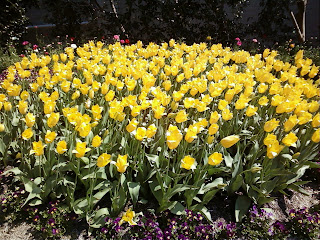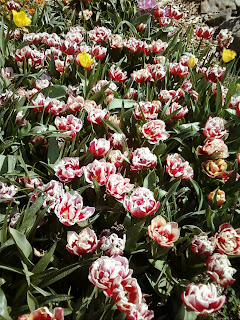It comes around once a year, and is followed by All Saints' Day. The sound of the name of the day itself can intrigue and create all sorts of fantasies involving horror creatures and fairy tales among the young and old. And yet, how many of us really know what it truly is about?
To many it is just the walking around of streets collecting treats from the neighbours. (To our family, it is offering carrot sticks, celery or cheese cubes, this year, as treats...We really weren't prepared for 'Trick or Treaters'.) To others, it is the avoidance of getting vandalised by young hooligans out for a good time - or playing out tricks to get 'revenge' on some past 'wrong'.
Yet, how did trick-or-treating begin? Why did we start celebrating such a thing? What is with the pumpkins? And why is it really starting to occur in Australia?
One
site refers to three different holidays that helped forge the tradition of what we know today as Halloween. It was a mixture of three different cultures: the Celts, the Catholics and the Romans - not necessarily in that order, though.
The Celts are meant to have believed that the night before their New Year (1st November) was a powerful time capable of bringing back the dead. They would light bonfires, apparently, and wear masks to ward off the terrible possibility of the dead appearing again. It can also be believed that they did this to celebrate the end of the Summer, and the end of harvest, bringing on the start of winter and the time of shorter days and deathly cold nights. The Druids (Celtic priests) would make predictions during this time, and this would help the people through their long winters. You must remember, these people were completely reliant upon the natural world in decreeing their lives. They would pray to their deities, re-light their hearth fires from the most sacred bonfire, and hope that the winter was a good one for all. Or, at least that is what is believed...
Next, the Romans capture the land that is inhabited by the Celts, and so incorporate their traditions upon the people. The Romans were very good at this. As mentioned on a documentary today that I showed my Yr 7 class: The Romans didn't create a large empire by being nice to people...
Anyway...They come along with two festivals that linked in well with the Celts' own celebration of Samhain (pronounced sow-in). This incorporation would have taken many years to actually have implemented, but by the time the Romans 'left' after roughly 400 years, they were there in place and taken as tradition. It is believed that, because of the Romans, the tradition of bobbing for apples is now part of many parties and celebrations of Halloween.
The Romans had two holidays that they celebrated: one late in October called Feralia, while the second was in honour of Pomona - the Roman goddess of fruit and trees. Feralia commemorated the dead, while Pomona's symbol was - you guessed it - an apple (hence the bobbing).
After the Romans, the Catholic religion edged in on the festivals occuring at this time of the year. Pope Bonafice IV apparently wished to replace the old Celtic festival that was related to the dead with something sanctified and religious, so he created All Saints' Day for the 1st November. This day honours the saints and martyrs and the deeds they did/achieved. It was also known, from the Middle English Alholowmesse (All Saints' Day), as All-hallows or All-hallowmas. The night before became known as All-hallows Eve and celebrated Samhain, leading eventually to the word Halloween.
Eventually, around 1000 AD, another day was inaugurated into the same time - All Souls' Day, the 2nd November. This was celebrated like Samhain with big bonfires, parades, and people dressing in costumes of angels, devils, and saints. In the end, all three days together - All Hallows Eve, All Saints' Day, and All Souls' Day - came to be known as Hallowmas.
But what about the pumpkins, the trick-or-treating, and it coming to Australia?
Well, apparently the holiday itself, in America, dates back to immigrants from Europe incorporating their ways into the community. By the 1920s and 1930s it had become common for this hoilday to be taken from a secular point of view, but to be celebrated within communities with parades and parties. It was around this time onwards that the idea of trick-or-treating was revived, as people could afford to make a contribution to a community event by just giving children small treats. This revival probably related back to the 'soul cakes' that were handed to people who begged during the festivals mentioned above. These original 'soul cakes' were, of course, encouraged by the church, and the people who received the cakes promised to pray for the dead relatives of those that gave the cakes out to the poor.
The idea of dressing up relates back to the time when people went from door-to-door in the neighbourhood asking for food, ale/wine or money, as well. However, they dressed up with at least a mask so as to disguise themselves from any ghosts that might be out there and were related to them. They wanted to hide from any ghosts, especially those that were malevolent, and it was thought that wearing a mask would make them blend in well with any ghosts, and not be recognised.

The idea of the pumpkins actually comes from Ireland, from the story about someone called 'Stingy Jack', who tricked the Devil into leaving him alone for a year or ten years as well as not claiming Jack's soul for Hell. When Jack did die he was not allowed into either Heaven or Hell (God did not want such an unsatisfactory person, and the Devil kept his promise), so he was sent away with just a lantern, carved out of a turnip, to guide his way. This eventually turned into pumpkins (as Americans could use the native fruit easily and they made great lanterns into the bargain), and people started carving scary faces into them over the centuries.
But Halloween as a tradition in Australia?
The most common reason for Australians to be participating in Halloween parties and/or trick-or-treating is because of the American influence we have had in society, especially since the 1940s/1950s. As America's holiday has become more and more popular, so it has spread within Australia. However, this does not mean that many people celebrate the 'festival' out here. Where there are young children in the streets you are bound to find some people going around on Halloween trying to collect treats. Older neighbourhoods don't tend to participate so much in the tradition.
Maybe, if people knew more about the origins of the holiday they would feel more inclined to join in. Then again...they might stick to the ideas that it's just an American 'thing.'




























